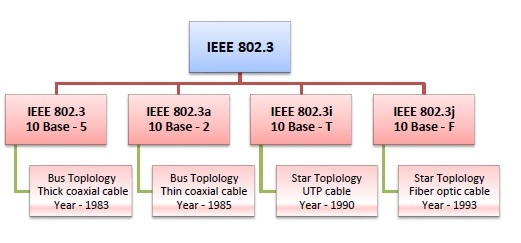
 Data Structure
Data Structure Networking
Networking RDBMS
RDBMS Operating System
Operating System Java
Java MS Excel
MS Excel iOS
iOS HTML
HTML CSS
CSS Android
Android Python
Python C Programming
C Programming C++
C++ C#
C# MongoDB
MongoDB MySQL
MySQL Javascript
Javascript PHP
PHP
- Selected Reading
- UPSC IAS Exams Notes
- Developer's Best Practices
- Questions and Answers
- Effective Resume Writing
- HR Interview Questions
- Computer Glossary
- Who is Who
What is IEEE 802.3?
IEEE 802.3 is a set of standards and protocols that define Ethernet-based networks. Ethernet technologies are primarily used in LANs, though they can also be used in MANs and even WANs. IEEE 802.3 defines the physical layer and the medium access control (MAC) sub-layer of the data link layer for wired Ethernet networks.
IEEE 802.3 Popular Versions
There are a number of versions of IEEE 802.3 protocol. The most popular ones are.
IEEE 802.3: This was the original standard given for 10BASE-5. It used a thick single coaxial cable into which a connection can be tapped by drilling into the cable to the core. Here, 10 is the maximum throughput, i.e. 10 Mbps, BASE denoted use of baseband transmission, and 5 refers to the maximum segment length of 500m.
IEEE 802.3a: This gave the standard for thin coax (10BASE-2), which is a thinner variety where the segments of coaxial cables are connected by BNC connectors. The 2 refers to the maximum segment length of about 200m (185m to be precise).
IEEE 802.3i: This gave the standard for twisted pair (10BASE-T) that uses unshielded twisted pair (UTP) copper wires as physical layer medium. The further variations were given by IEEE 802.3u for 100BASE-TX, 100BASE-T4 and 100BASE-FX.
IEEE 802.3i: This gave the standard for Ethernet over Fiber (10BASE-F) that uses fiber optic cables as medium of transmission.

Frame Format of IEEE 802.3
The main fields of a frame of classic Ethernet are -
Preamble: It is a 7 bytes starting field that provides alert and timing pulse for transmission.
Start of Frame Delimiter: It is a 1 byte field that contains an alternating pattern of ones and zeros ending with two ones.
Destination Address: It is a 6 byte field containing physical address of destination stations.
Source Address: It is a 6 byte field containing the physical address of the sending station.
Length: It a 7 bytes field that stores the number of bytes in the data field.
Data: This is a variable sized field carries the data from the upper layers. The maximum size of data field is 1500 bytes.
Padding: This is added to the data to bring its length to the minimum requirement of 46 bytes.
CRC: CRC stands for cyclic redundancy check. It contains the error detection information.


